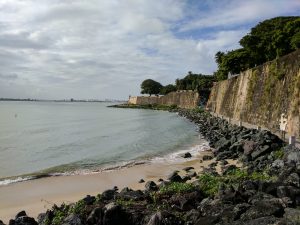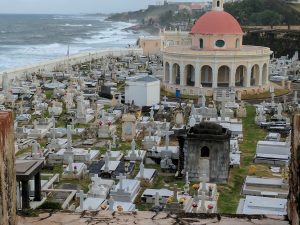I forgot how much I missed that sweet, sweet kiss of tropical air.
Uber is not allowed to pick up passengers from the Airport, so taking a taxi (or bus) was my only option. A taxi to the Mango Mansion, the hostel I’m staying at, cost me $19USD: reasonable!

Getting in at a decent time, I decided to hit up Old San Juan. This was the original city centre back when Spain ran the island. Today it’s a mix of tourist traps and old Spanish architecture. All of the cruise ships that dock in San Juan dump their hordes of passengers here. So every shop in town has signs declaring heavy discounts to those who are disembarking from a vessel.
That aside, Viejo San Juan still has a lot of interesting history behind it. I began my discovery by starting at Puerta De San Juan. This was the original door to the city built by the Spaniards in 1635. Walking through the door I was imagining all of the sailors, dignitaries, royalty, and even pirates that have crossed its threshold over the past 400 years.

The walk around the bay, along the walls, was serene and peaceful. The waves washing up against the shore and the cool sea breeze helped quench the 30°C heat. My destination was Castillo de San Felipe del Morro, the fort that defended the town up until World War II. Entrance was $5USD, which also gave you access to the other castles and strongholds in the city. To note: the entire network of castles has been declared a World Heritage Site.
The government continued to use this location to protect Puerto Rico during World War II by modifying the castle to handle the anti-aircraft guns that were used at the time. Even 400 years later, this was a prime place to keep the city safe!
On the other side of the Castle, is a sick ass cemetery called Cementerio Santa María Magdalena de Pazzi.

At this point it started to rain, so I decided to cut my trip to the Cemetery short and head back to the hostel.

On the way back I really noticed and paid attention to how serious the Puerto Ricans take Christmas. Wreaths, Christmas trees, lights, and garlands are everywhere in the city. It’s still a funny sight for me to see, considering this is a tropical island.
Navidad, as it’s called here, is an important part of Puerto Rican culture. School children have the ten days off before and after Christmas to spend time with their family and in church.
The traditional Christmas dinner is usually lechón asado, which consists of roast pork served with rice and peas, and plantains. The pork is spit roasted for hours until it’s ready.
For me, personally, the thought of Christmas is the last thing on my mind. I’m sure that will change in a week when I get to meet up with two good friends from home.
Today was all about the history and travelling back in time. Tomorrow’s trip is going to take me someplace a little more futuristic.
